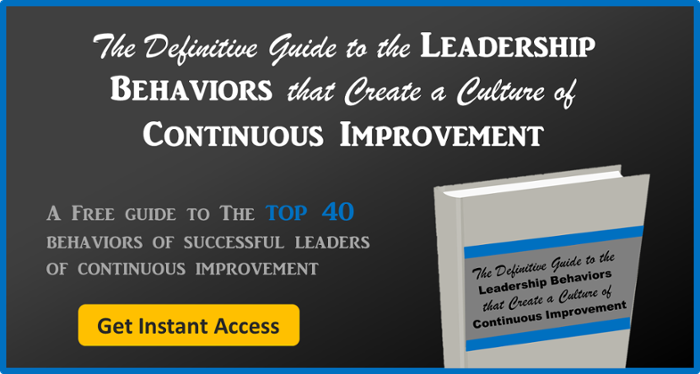 Every organization is different and no doubt there are some things that are unique to yours. But after years of working with many types of companies of all sizes in a variety of industries, we’ve noticed a pattern in those that are able to effectively start, spread, and sustain a culture of continuous improvement. Here is what they all seem to have.
Every organization is different and no doubt there are some things that are unique to yours. But after years of working with many types of companies of all sizes in a variety of industries, we’ve noticed a pattern in those that are able to effectively start, spread, and sustain a culture of continuous improvement. Here is what they all seem to have.
1 - Engaged Leadership
While improvement efforts can certainly be bottom-up, commitment to positive change must start at the top. Employees need to see that executive leadership values improvement work and is willing to make an investment in related efforts.
This can take the form of:
- Actively working on improvement projects
- Recognizing and rewarding people who contribute ideas and effort
- Adequately budgeting for improvement related work and tools
- Allowing time to be devoted to continuous improvement training
- Walking the Gemba
Learn more about the need for committed, engaged leaders here.
2 – Consistent Methodology
When improvement efforts are undertaken haphazardly, results are unpredictable and uneven. The most successful organizations adopt a consistent method for identifying and acting on ideas for improvement. They develop a common language that streamlines communication between teams. They also use a unified system for measuring improvement and holding employees accountable.
With a consistent approach to continuous improvement, everyone knows what to expect and what is expected of them.
Learn more about creating a disciplined improvement methodology here.
3 – Enabling Technology
Technology supports continuous improvement in a number of ways. It makes it easy for employees to capture and implement opportunities for improvement. It keeps improvement work top of mind with alerts and smart notifications, and provides a dashboard so that managers can track the progress of improvement projects. It also gives executives a view into the progress of the entire organization. Cross-functional collaboration is easier when everyone has one platform for communication around improvement work. It also serves as the repository of knowledge for improvement across an organization, breaking down silos and ensuring that each improvement has a widespread and lasting impact. Perhaps most importantly, it allows for the measurement of the business impact of improvement work, something that is critical to pillar #1.
There are certainly other factors that impact how successful an organization can be with continuous improvement, but these three form the foundation upon which a successful and sustainable approach to improvement can be built. If improvement in your organization occurs in fits and starts, it’s smart to look at these pillars of improvement and see what you might be missing.



Add a Comment